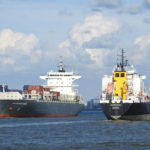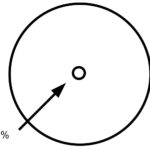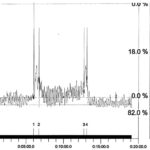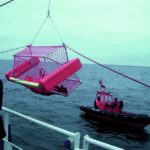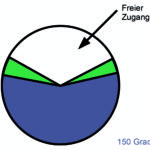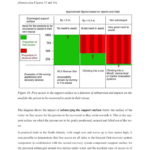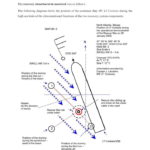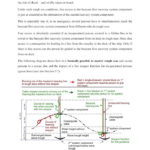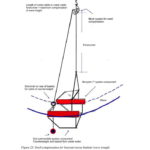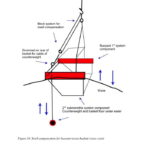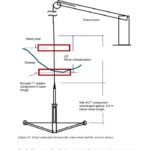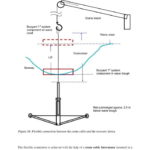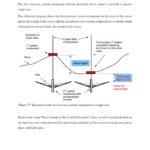Research report on main recovery-related problem areas in the rescue of persons in distress at sea and recovery-related requirements to be met by life-saving appliances
Prof. Michael Schwindt
3.3 Free access to the life-saving appliance when casualties swim towards it
The following are necessary
• Ease of use and accessibility for a person adrift in the water without seafaring knowledge and experience.
• Securing persons to and / or in the life-saving appliance.
• Protection against injuries.
Experimental trials have demonstrated the drawbacks of a limited access area for an exhausted person in the seaway. In an emergency, this can result in failure of the recovery operation.
The recovery-related importance of free access – a fundamental requirement – is thus of crucial design relevance for the general requirements that have to be met by life-saving appliances (see Figures 11 in Part 1 and 16).
The diagram in Fig. 16 shows the impact of submerging the support surface below the surface of the water on free access for the persons to be recovered as they swim towards it. This is the support surface on which the persons are to be gently positioned, secured and lifted out of the water.
In practical trials in the North Atlantic, with rough seas and waves up to 4 m high, it was possible to demonstrate that free access on all sides to the buoyant first recovery system component in combination with the second recovery system component (support surface for the persons) submerged around two metres under water and the resultant ease of access is of crucial recovery-related importance in terms of being able to secure persons on and / or in the life-saving appliance in rough seas.
The recovery situation to be mastered was as follows: The diagram in Fig. 17 shows the position of the container ship MV LT Cortesia during the high sea trials of the aforementioned functions of the two recovery system components: The dummy was lowered into the water three times, and each time it was positioned accurately and securely on the net of the Rescue Star in a horizontal position – thereby minimizing the risk of shock – and swiftly taken on board.
Under such rough sea conditions, free access to the buoyant first recovery system component is just as essential as the submersion of the second recovery system component. This is especially true if, in an emergency, several persons have to simultaneously reach the buoyant first recovery system component from different sides in rough seas.
Free access is absolutely essential if an incapacitated person secured to a lifeline has to be towed to the buoyant first recovery system component from on deck in rough seas. Here, free access is a prerequisite for hauling in a line from the casualty to the deck of the ship. Only if there is free access can the person be guided to the buoyant first recovery system component from on deck.
The diagram in Fig. 18 shows how it is basically possible to master rough seas and secure persons to a rescue disc and the impact of a line stopper function for incapacitated persons (green lines) (see also Section 3.7). The requirement for free access thus takes precedence over stability-related extreme stress requirements to be met by the life-saving appliance, which do not become relevant until the appliance is actually accessible under extreme conditions. It must be possible for persons to swim to the appliance without obstruction, and this must be made a requirement. This may entail design constraints on stability-related extreme stress requirements.
3.4 Meeting the medical requirements
Today’s generally accepted and scientifically proven medical requirements to be met by maritime recovery systems have been substantiated and demonstrated by Dr Wolfgang Baumeier in the SARRRAH project of the Department of Anesthesiology, University Medical Center Schleswig-Holstein (UK S-H), Campus Lübeck.
Physicians are in unanimous agreement that the basic principle for recovering weakened and hypothermic persons from the water is a gentle and horizontal recovery to avoid circulatory failure. The casualty should be moved as little as possible to prevent cold peripheral blood from entering the weakened minimum circulation, which is just about keeping the casualty alive. It is also important that the casualty avoids physical exertions, stress and any constriction of the respiratory muscles.
The fear among maritime rescue services is that persons they have recovered from the water alive will suffer a circum-rescue collapse, which is frequently fatal. Any shipwrecked person will very quickly become hypothermic to a greater or lesser extent. Initially, their muscle functions will be increasingly impaired. If the core of the body also cools down, the diuresis caused by the cold and the weakening of myocardial activity will result in a critical lability of the circulation.
It is a proven fact that recovery from the water leads to a drop in blood pressure in the central veins and destabilizes the circulation. The effects of this become increasingly drastic the more the casualty is moved from a horizontal to a vertical position. This has been proven beyond all doubt by Surgeon Rear Admiral Frank Golden at the Institute of Naval Medicine in Hampshire (UK). Circulatory collapse can have various causes:
• the main cause is a reduction in hydrostatic pressure support on the venous return;
• the influence of gravity;
• increased viscosity of the blood;
• reduced output of the cooled myocardium;
• the reduced time interval for filling the coronary arteries;
• weakened baroreceptor reflexes.
As early as 1991, Golden showed in a study that, during a winching operation with a single helicopter sling, the central venous pressure fell by around 12 mm of mercury after 30 minutes in 15 centigrade cold water. If ventricular fibrillation then occurs, the shipwrecked person can only be saved by means of sustained resuscitation measures, which have to be continued without interruption until they reach a suitable medical facility.
A rescuer at a distance from the casualty can never judge the actual degree of hypothermia or the circulatory situation. The prime objective must therefore be, wherever possible, to recover a person from the water in a horizontal or semi-horizontal position and without any unnecessary change in position. Under no circumstances should the person be forced to climb out of the water into the dry themselves. Only in a horizontal rescue position can a potentially fatal collapse of the person suffering from extreme hypothermia be effectively prevented. In May 2006, IMO included this very requirement in its regulations and called for technical solutions.
With the submerged net, persons can be automatically positioned horizontally as the crane lifts the second recovery system component out of the water. Together with the second recovery system component, which acts as a counterweight under the water, a net that is stretched horizontally over a collapsible frame or similar can be submerged to a sufficient depth (around two metres) below the wave trough to pick up a person from below.
Impact of circulation-friendly positioning on heart rate
• Phase 1 (left): Rest phase before the test, lying on a mat
• Phase 2 (centre): Semi-horizontal position in the RLS-double strops
• Phase 3 (right): Rest phase, measuring the impact
3.5 Automatically securing the casualty against falling out
If the recovery-related advantage of a two recovery system component solution is used in the design of the life-saving appliance, the submersible second recovery system component can be provided with a net or another stable, horizontally arranged surface which, when a load is imposed on it by supporting one or more persons, can automatically expand to form a trough in which the persons are protected against falling out, even if it is flung against the ship’s side (see Figure 13 in Part 1 and Fig. 19).
If use is made of the crane cable length regulation as described in section 3.1.5 (… in other variants, the slack of the crane cable that arises in the seaway is deflected behind the float of the life-saving appliance by a counterweight), the casualty can be automatically secured against falling out of a rescue basket by, for instance, automatic swivelling of the front half of the floor as it is lifted, so that the persons who have swum into the basket cannot be flung out. This system, too, has the aforementioned second recovery system component for submersion under the surface of the water (with the help of the basket floor).
The counterweight required for regulating the length of the crane cable is arranged separately behind the basket and thus guides any crane cable slack to the rear of the basket, so that the entrance to the basket is kept open.
3.6 Equipment for bringing people aboard
This section refers to the launch and recovery equipment and the possibilities of connecting it to a crane or winch.
The speed requirement for launch and recovery equipment for systems for the recovery of persons is at least 0.3 m per second in rough seas with waves up to 3 m high. This concerns the suitability of cranes and winches. If, on the submersible second recovery system component, the crane cable is used as a guide cable for the first recovery system component (rescue disc), this results in variants of the crane usage for a recovery device of this kind.
3.6.1 Fixed connection
Here, the 10 mm crane cable is fixed in a special coupling in the second recovery system component.
• Advantages:
– The entire system is immediately operational.
– The unlimited lift of the first recovery system component makes it possible to master very high waves.
– A fixed connection between the recovery device and the crane cable can, with the help of the special coupling located in the guide tube of the second recovery system component of the RLS-Rescue Star, be disconnected for the optional temporary mounting of a crane hook or other crane use.
– The crane cable can be disconnected in the recovery device.
• Disadvantages:
– none.
3.6.2 Flexible connection
The flexible connection is achieved with the help of a crane cable forerunner mounted in a special coupling in the second recovery system component.
• Advantages:
– The entire system is immediately operational: by attaching the crane cable forerunner to a crane hook.
– The use of the crane can be quickly changed: the crane cable is permanently available for other functions.
– The permanent but detachable connection between the recovery device and the crane cable forerunner is ensured by a special coupling.
• Disadvantages:
– The restricted lift of the first recovery system component limits the ability to master wave heights as a function of the length of the crane cable forerunner.
– The maximum length of a crane cable forerunner is dependent on the ship’s structure.
3.7 Mastering increasingly rough seas
The two recovery system component solution described above makes it possible to master rough seas. The following diagram shows the first recovery system component on the crest of the waves and in the trough of the waves and the second recovery system component at a constant depth of around two metres below the trough of the waves. Trials in the Large Wave Channel at the Coastal Research Centre, as well as practical trials on the high seas, have demonstrated the operational capability of the system in rough seas and on ships with high sides. To be continued in the next issue
Professor Michael Schwindt






